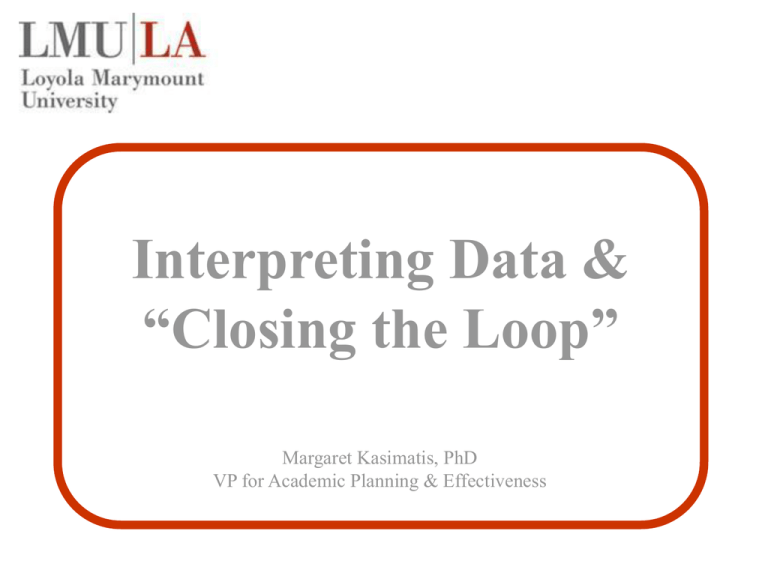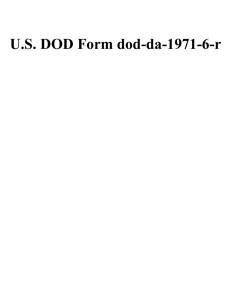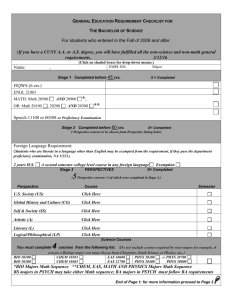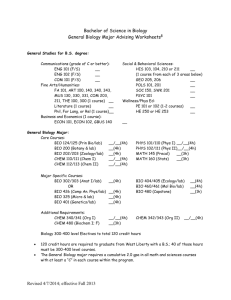Interpreting Data & “Closing the Loop”
advertisement

Interpreting Data & “Closing the Loop” Margaret Kasimatis, PhD VP for Academic Planning & Effectiveness Location in Assessment Cycle IDENTIFY SPECIFIC OUTCOMES DETERMINE PRACTICES USED TO ACHIEVE OUTCOMES GATHER EVIDENCE ARTICULATE MISSION/ GOALS RECOMMEND ACTIONS REVIEW & INTERPRET RESULTS Step #1: Organize Your Data • Assemble the following in one place: – All data or possible sources of data – List of learning outcomes/research questions – Curriculum, experiences, practices • Map data sources to outcomes – Outcomes x Measures Map • Map results to outcomes – Present in “user-friendly” way Mapping Data Sources to Outcomes: Engineering Example ASSESSMENT MEASURES LEARNING OUTCOMES Alumni Survey Ability to apply knowledge in math, science, and engineering National Survey of Student Engagement (NSSE) Evaluation of Clinic Presentations Evaluation of First-Year Presentations X Rubric Evaluation of Upper-level Coursework X Ability to design a system, component, or process to meet desired needs X Ability to identify, formulate, and solve engineering problems X X Ability to communicate effectively X X Ability to use techniques, skills, and modern engineering tools necessary for engineering practice X X X X X X X Ability to function on multidisciplinary teams X X Recognition of need for and ability to engage in lifelong learning X X Understanding of professional and ethical responsibility X X Broad education necessary to understand the impact of engineering solutions in a global & societal context X X Presenting Results • It’s best to present results one outcome at a time – It’s not recommended to present results primarily by measure • Make sure to present the data in a userfriendly way (i.e., in a way that faculty in your department are comfortable with) HMC Senior Engineers AITU Seniors Liberal Arts Seniors Mean Response (1-4 scale) 4 3 2 1 Experience contributed to ability to write clearly and effectively Rubric Evaluation of Student Work: Writing Style Mean Rubric Score on Writing Style (1-5 scale) NSSE: Data on Communication Skills Percent Indicating "Very Much" 60 Biology Chemistry Comp Sci Engineering Math Physics 40 4 3 2 1 Experience contributed to ability to speak clearly and effectively Course #1 Alumni Survey: Data on Communication Skills 50 5 Course #2 Rubric Evaluation of Student Presentations 4 Delivery Language Organization Content 3 30 20 2 10 0 To what extent was an emphasis on writing skills present while you were at HMC? To what extent was an emphasis on oral communiction skills present while you were at HMC? 1 First-Year Presentation Clinic Presentation NSSE LMU Jesuit Master’s Total ACADEMIC CHALLENGE: How often did you work harder than you thought you could to meet an instructor's standards or expectations? FY 62% 55% 54% 52% (Percent of students who said ‘Often’ or ‘Very Often) SR 54% 59% 60% 56% How much time did you spend preparing for class (e.g. studying, FY 65% 68% 49% 56% SR 40% 58% 52% 54% FY 21% 17% 17% 19% (Percent of students who said ‘Often’ or ‘Very Often’) SR 27% 23% 20% 23% Describe the extent in the current year to which exams challenged you to do your best work. FY 5.47 5.56 5.33 5.42 (mean response on a 7-point scale) SR 5.33 5.46 5.43 5.40 reading, writing, doing homework, rehearsing, other academic activities)? (Percent of students who reported spending 11 or more hours per week) How often did you come to class without completing readings or assignments? Step #2: Interpret the Data • What type of criterion? • What is “significant?” • Are the findings reliable/valid? What type of criterion? • Norm-referenced – Need appropriate comparison group • Avoid percentile rankings – Good for more nebulous findings • Absolute standard – Usually more appropriate for performance-based measures What is significant? • Important to test when making comparisons – Numbers that look different may not really be different • However, just because a difference is significant doesn’t mean it’s important Are findings reliable/valid? • Can we believe student self-reports? • Are standardized measures more valid? • Single measure vs. multiple measures Step #3: Make Recommendations • Start by considering – Where in the curriculum are outcomes addressed? And at what level? • Refer to (or create) curriculum map, or • Inventory for particular outcome – How? What practices/techniques are used? – Where are the gaps? – What can be changed? • In the short-term? In the long-term? Step #3: Make Recommendations • Possible types of recommendations: – Changes to pedagogy – Changes to curriculum/programming – Allocation of resources • Keep in mind that you can’t fix everything at once – so start small • It’s usually better to modify than add • Be as specific/concrete as possible Step #4: Implement & Document Recommend Actions Example PROPOSED ACTION IMPLEMENTATION Document (with grades) the importance of presentation clarity Essay questions added to exams Engineering Curriculum Committee developed writing rubric to be used to evaluate project report Department selected Hacker, A Writer’s Make common writing style guidelines available to faculty Reference and students Hacker, A Writer’s Reference required in E4 Hold Clinic team members accountable for peer review of team reports Clinic advisors distributed peer review sheets to Clinic team members. Students completed the peer review sheets when they reviewed fellow team members’ portions of Clinic report . Example of Assessment Loop • Step #1: Articulate Goals/Outcomes – Goal: Graduates will possess strong communication skills • Outcome: Graduates will be able to write clearly and effectively • Step #2: Determine practices used to achieve outcome – Survey of required writing experiences in Core and academic programs Sem # BIO CHEM CS ENG MATH PHYS One 4 papers Two Three H/SS Report in E4 1-2 papers in Bio 101 Tech report in Phys 28 Lab notebook & paper in Chem 53 4 papers Tech report in Phys 53 3 lab reports Four 4 lab reports 1-2 papers in Bio 108 Five Six Essays/paper in Chem 52 Lab notebook Exp abstracts 1-2 papers in Bio 109 3 reports + paper in 109 3 lab reports Exp abstracts 1-2 papers in Bio 113 Design doc, Report, & User guide in CS 121 Tech report in Phys 54 Term paper in Phys 52 Abstracts in CS 110 Proposal & mid-year report OR Project paper in Chem 114 Essay in CS 131 Clinic report IE Paper IE Paper IE Paper IE Paper Proposal Letter of Intro 3 Lab reports Prog report Proposal + midyear report Proposal + midyear report Variable Amount Of Writing Tech report in Phys 134 Seminar paper Seven IE Paper IE Paper Seminar Researc h Paper Example of Assessment Loop, cont’d • Step #3: Conduct measurements – Higher Education Research Institute (HERI) College Student Survey (CSS) – National Survey of Student Engagement – HMC Alumni Survey Example of Assessment Loop, cont’d • Step #4: Review & interpret results – Faculty committees • Assessment • Curriculum • Teaching & Learning – Full faculty - workshop Writing Skills Frequency data from HERI, NSSE & Alumni Survey 80 70 60 Liberal Arts 50 40 4-Yr NonSectarian 30 20 HMC Seniors HMC AITU Seniors Seniors 1959-19871988-2001 Cohort Cohort 10 0 "Much stronger writing skills than when entering college" "Institution contributed very much to ability to write clearly and effectively" "To what extent was an emphasis on writing skills present while you were at HMC?" (5) To what extent did experiences at your institution contribute to your ability to write clearly and effectively? Seniors’ Perceptions of Writing Skills by Major (from NSSE) 4 3.5 3 2.5 2 1.5 1 Biology CS Engineering Mathematics Physical Sciences Writing emphasis was "very much" present Alumni Perceptions of Writing Emphasis by Major (alumni graduating in last 10 years) 70 60 50 40 30 20 10 0 Biology Chemistry CS Engineering Math Physics Sem # BIO CHEM CS ENG MATH PHYS One 4 papers Two Three H/SS Report in E4 1-2 papers in Bio 101 Tech report in Phys 28 Lab notebook & paper in Chem 53 4 papers Tech report in Phys 53 3 lab reports Four 4 lab reports 1-2 papers in Bio 108 Five Six Essays/paper in Chem 52 Lab notebook Exp abstracts 1-2 papers in Bio 109 3 reports + paper in 109 3 lab reports Exp abstracts 1-2 papers in Bio 113 Design doc, Report, & User guide in CS 121 Tech report in Phys 54 Term paper in Phys 52 Abstracts in CS 110 Proposal & mid-year report OR Project paper in Chem 114 Essay in CS 131 Clinic report IE Paper IE Paper IE Paper IE Paper Proposal Letter of Intro 3 Lab reports Prog report Proposal + midyear report Proposal + midyear report Variable Amount Of Writing Tech report in Phys 134 Seminar paper Seven IE Paper IE Paper Seminar Researc h Paper Example of Assessment Loop, cont’d • Step #5: Recommend actions – Universal writing handbook – Faculty workshop on writing instruction – Revision to Core Curriculum MULTIPLE CURRICULAR OBJECTIVES IN HORIZONTALLY INTEGRATED CORE CURRICULUM • Content • Skills Context • • • • • • • disciplinary knowledge discipline-related techniques oral and written communication critical thinking teamwork and collaboration project management leadership relationship of science or technology with contemporary society individual and comparative explorations of cultural identity QUESTIONS?




